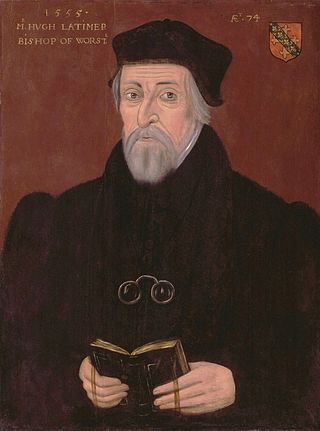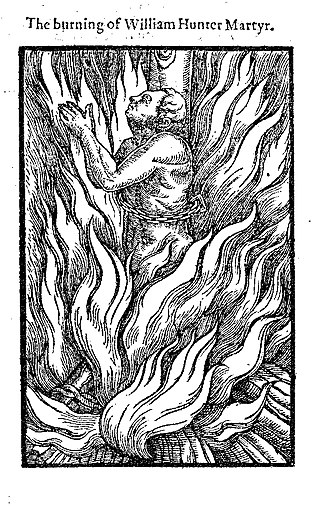Related Research Articles

Hugh Latimer was a Fellow of Clare College, Cambridge, and Bishop of Worcester during the Reformation, and later Church of England chaplain to King Edward VI. In 1555 under the Catholic Queen Mary I he was burned at the stake, becoming one of the three Oxford Martyrs of Anglicanism.

William Hunter was a Marian martyr burnt to death in Brentwood, England at the age of 19 on 26 March 1555, on Ingrave Road. He had lost his job in London as a silk-weaver because he refused to attend the Catholic mass, despite an order that everyone in the City of London had to attend, and had come to live with his parents in Brentwood, but got into a dispute when discovered reading the Bible for himself in Brentwood Chapel. He refused to accept the Catholic dogma of transubstantiation according to which the bread and wine of the communion become the body and blood of Jesus.

Rowland Taylor was an English Protestant martyr during the Marian Persecutions.

Sir Clement Higham MP JP PC of Barrow, Suffolk, was an English lawyer and politician, a Speaker of the House of Commons in 1554, and Chief Baron of the Exchequer in 1558–1559. A loyal Roman Catholic, he held various offices and commissions under Queen Mary, and was knighted in 1555 by King Philip, but withdrew from politics after the succession of Queen Elizabeth I in 1558.

John Bradford (1510–1555) was an English Reformer, prebendary of St. Paul's, and martyr. He was imprisoned in the Tower of London for alleged crimes against Queen Mary I. He was burned at the stake on 1 July 1555.
Agnes Potten and Joan Trunchfield were two English Ipswich women who were imprisoned and burned at the stake during the Marian persecutions: both are commemorated among the Ipswich Martyrs. Their arrest followed immediately after the burning of Robert Samuel.

George Marsh was an English Protestant martyr who died in Boughton, Chester, on 24 April 1555 as a result of the Marian Persecutions carried out against Protestant Reformers and other dissenters during the reign of Mary I of England. His death is recorded in Foxe's Book of Martyrs.
Joan Waste or Wast was a blind woman who was burned in Derby for refusing to renounce her Protestant faith.

The Coventry Martyrs were a disparate group of Lollard Christians executed for their beliefs in Coventry between 1512 and 1522 and in 1555. Eleven of them are commemorated by a six-metre-high (20 ft) monument, erected in 1910 in a public garden in the city, between Little Park Street and Mile Lane; and by a mosaic constructed in 1953 inside the entrance to Broadgate House in the city centre. Some of the streets in the city's Cheylesmore suburb are named after them.

Thomas Hawkes was an English protestant martyr who burned to death in 1555 during the Marian Persecutions rather than allow his son to be baptised into the Roman Catholic Church.

The Colchester Martyrs were 16th-century English Protestant martyrs. They were executed for heresy in Colchester, Essex, during the reigns of Henry VIII and Mary I. Their story is recorded in Foxe's Book of Martyrs.
The Canterbury Martyrs were 16th-century English Protestant martyrs. They were executed for heresy in Canterbury, Kent and were the last Protestants burnt during the reign of Mary I. Their story is recorded in Foxe's Book of Martyrs.
Thomas Tomkins was a 16th-century English Protestant martyr. He was a weaver from Shoreditch, London, and was examined by Bishop Bonner. Despite having been subjected to torture, he insisted that he did not believe in transubstantiation. As a result, he was burned to death at Smithfield on 16 March 1555. His story is recorded in Foxe's Book of Martyrs.
Stephen Knight was a sixteenth-century English Protestant martyr. His story was recorded in Foxe's Book of Martyrs. For denying transubstantiation, he was burned to death at Maldon, Essex.

The Actes and Monuments, popularly known as Foxe's Book of Martyrs, is a work of Protestant history and martyrology by Protestant English historian John Foxe, first published in 1563 by John Day.
John Philpot was an Archdeacon of Winchester and an English Protestant martyr. He was burned at the stake in Smithfield on 18th December 1558. The story of his imprisonment and execution is recorded in Foxe's Book of Martyrs published in 1563.

Mary Honywood or Mary Waters was a British co-heiress who visited the Marian martyrs. She lived to have 114 grandchildren and, in total, 367 descendants in her lifetime.

The Stratford Martyrs Memorial is a memorial that commemorates the group of 11 men and two women who were burned at the stake together for their Protestant beliefs, at Stratford-le-Bow or Stratford near London in England on 27 June 1556, during the Marian persecutions.
References
- ↑ p.257, John Foxe, Foxe's Book of Martyrs , 2000, Ambassador Publications
- ↑ Foxe's Book of Martyrs , https://www.exclassics.com/foxe/foxe277.htm
- ↑ Open Plaques http://openplaques.org/people/9211